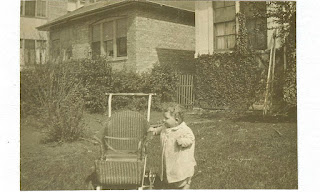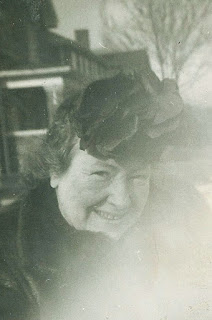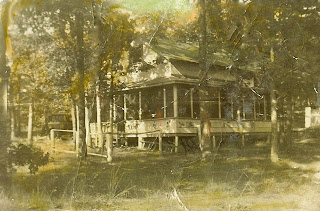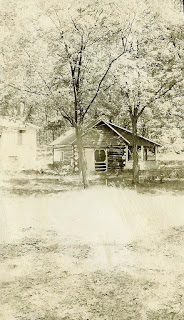In her own words (Part Eight)
– Joan Huesca
Copyright © 2012 Linda Huesca Tully
– Joan Huesca
Copyright © 2012 Linda Huesca Tully
 |
| My mother, Joan Schiavon, first row, far right. I do not know who the other children are – could one of them be Rosemary Reize? |
“School Days in St. Joachim’s suddenly became much more exciting for Rosemary went to school there, too! We were preparing to make our First Holy Communion, and during our religion studies, we learned all about the Poor Souls in Purgatory. Angels that we were, we dedicated much of our time praying for those poor souls. Then, we decided that maybe prayers really weren’t enough…so we would go to church early in the morning before school began, again at lunch time, and finally after school. Each time, we would light ALL the candles in the church, kneel down and say a prayer as we lit each candle. Father Hanley (the pastor of the church) would come in and find the church ablaze with candlelight, altar included. We were finally apprehended, and our parents received a bill, ‘For the Poor Souls in Purgatory.’
– Joan Huesca
– Linda Huesca Tully
“Genius or not, Tom was a problem to the school and the Sisters who taught there. My mother claimed that she spent most of her time traveling from the house to the Principal’s office to see what Tom had gotten into almost daily. One time, she arrived at Tom’s classroom to find the Sister covered from head to toe with grease from an engine Tom had brought to school. Another time, she was called to the Principal’s office to find my brother and a representative of the Street Car Line. Seems Tom had decided to conduct a scientific experiment to see how awake and aware people were early in the morning, and had taken my Mother’s clothesline and interlaced it between the handles on each seat, then sat and watched people on their way out of the street car, falling as they went, and deduced that they really weren’t wide awake after all.
 |
| Emmanuella (Sannella) Schiavon, Chicago, Illinois |
“Finally, though, it was time to start first grade, and I couldn’t escape from that reality. My cousins Jane and Buddy* took me to St. Dorothy’s School, dutifully placed me at the end of a long line of children, then got in their respective lines, and in all the confusion of so many children in the school yard, somehow, I would manage to break away and walk home. There I would be found sitting on the front steps waiting for Grandma to come down and let me in. I didn’t want to leave my two darlings, and school became a terrible drudge to me.
 |
| Note the submarine name, “USS South Carolina” inscribed in Ralph Schiavon’s sailor’s hat. |
“
joined the United States Navy during World War I, and was active on a submarine. He used to say how frightened he was, especially since he and his shipmates would be locked into a compartment when the ship was submerged. Daddy…was stationed at Great Lakes Naval Training Station, near Chicago. There, he met my Mother. When they married, a few years later, Daddy got a job working in a shoe store, and he attended a night school, until finally, he received a degree to practice government tax laws. The purpose of this long tale, is to relate to you, something which has always impressed me, with the drive and ambition of this great man who was to be my Father. His example has been a part of my being since I can remember. I guess I have believed, because of him, that if you try hard enough, and put your goals high enough, you can do anything.
 |
| My mother at about a year old, Chicago, Illinois |
 |
| My grandmother, Alice McGinnis Schiavon, about 1935, Chicago, Illinois |
 |
| Bunny Rest, so named by my grandmother, Alice (Gaffney) Schiavon, because that was where the family went to rest what she referred to as their “bunnies.” Big Blue Lake, Michicgan, about 1945 |
 |
| Back row, right: My aunt and godmother, Angelina “Angie” (Ciliberto) Schiavon. Front row, center: My mother, Joan Schiavon. About 1946, Bunny Rest Cottage, Big Blue Lake, MI |
 |
| My mother told me that her Great Uncle Bill McGinnis also built this (red, I think) log cabin on his property, not far from Bunny Rest. |
– Joan Huesca
 |
| My mother, Joan Schiavon (far left), with her cousins, Benita Jane “Janie” and Phillip “Bud” McCormick, about 1931, Chicago, Illinois |
I guess that Grandma McGinnis was the example of what I always had hoped I would be like. Grandpa [Thomas Eugene] McGinnis died a year before I was born, but always it seemed to me that Grandma had lived just for him, loving him completely. (I, too, have been blessed with the dearest Husband ever, so it seems my prayers had been answered in that respect.) Grandma had the bluest eyes. How well I remember them, they were always full of love. Two days a week were ‘baking days,’ and Grandma would produce all kinds of delicious pies, cakes, and bread.
 |
| Elizabeth Gaffney (1862 – 1934) The back of this photograph reads “Pin-Lock Medal, Chicago” and is dated May 31, 1898. |
There was always extra dough, most of the extra would be made into ‘little pies,’ little triangles with either cinnamon and sugar inside, or ‘leftover’ apple slices from the bigger pies. The ‘little pies’ were just for me. I can remember sitting at the kitchen table for hours, my nose barely reaching the top, rolling a little ball of dough (sort of smudged looking, ’cause my hands weren’t always as clean as they should have been), and when Grandma would turn her back, I’d pop the whole thing into my mouth.
 |
| Elizabeth “Lyle” Gaffney’s millinery shop, early 1900s, either Conneaut or Cleveland, Ohio. She also made hats for Annie Sullivan, Helen Keller’s teacher and was the chief milliner for Marshall Fields Department Store in Chicago. |
Joan Joyce (Schiavon) Huesca
1928 – 1987
On June 24, 1987, a couple of months before she died of lung cancer, my mother, Joan Joyce (Schiavon) Huesca began writing the story of her life. The following is an excerpt from the first chapter of her book, Joan Joyce Schiavon Huesca: an Autobiography, in which she describes one of her earliest memories:
 |
| Cover of my mother’s autobiography, 1987, Modesto, California (published privately) |
“I have been told that I was a cuddly blonde with a mass or curly ringlets atop my head, crowned with a big pink bow. My dress was of a pink satin tunic with a pink net full short skirt decorated with little blue satin rosebuds. Dressed in all my finery, my parents took me to a social gathering at the American Legion Hall (Woodlawn Post)., of which my father was a member, having served on a submarine in the U.S. Navy during World War I. I can remember their being very proud of their “doll-like” little girl. There I was, standing right in front of two big doors which led into a large hall, filled with BIG PEOPLE! I can remember so clearly, feeling so frightened, and I began to cry, as I seemed to be the smallest and only little girl there. Tearfully and red-faced, I tried to pull back from those doors…but to no avail, as I made my entrance to society puffy-eyed and sobbing. To this day, I feel that same bit of timidness in a large group of people with whom I am not well acquainted.”
– Joan Huesca
Joan Joyce (Schiavon) Huesca
(1928 – 1987)
 |
| Joan at about a year old, Chicago, 1928 |
Joan’s arrival was great cause for celebration in the Schiavon and McGinnis households. Mary Jane (Gaffney) McGinnis, her maternal grandmother, was beside herself with joy. Looking at Joan’s fair face and tiny brunette curls, she concluded that her beloved husband, Thomas Eugene McGinnis, who had died in 1927, had chosen my mother specially from the angels in heaven and sent her to his grieving family. The thought of this was a great comfort to Mary Jane, and it formed a special bond between my mother and her Grandma McGinnis that would endure for the rest of their lives.